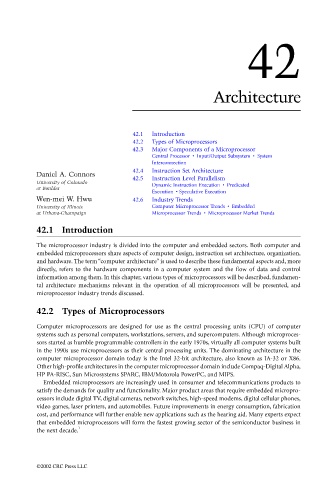Page 1122 - The Mechatronics Handbook
P. 1122
42
Architecture
42.1 Introduction
42.2 Types of Microprocessors
42.3 Major Components of a Microprocessor
Central Processor • Input/Output Subsystem • System
Interconnection
42.4 Instruction Set Architecture
Daniel A. Connors
42.5 Instruction Level Parallelism
University of Colorado Dynamic Instruction Execution • Predicated
at Boulder
Execution • Speculative Execution
Wen-mei W. Hwu 42.6 Industry Trends
University of Illinois Computer Microprocessor Trends • Embedded
at Urbana-Champaign Microprocessor Trends • Microprocessor Market Trends
42.1 Introduction
The microprocessor industry is divided into the computer and embedded sectors. Both computer and
embedded microprocessors share aspects of computer design, instruction set architecture, organization,
and hardware. The term “computer architecture” is used to describe these fundamental aspects and, more
directly, refers to the hardware components in a computer system and the flow of data and control
information among them. In this chapter, various types of microprocessors will be described, fundamen-
tal architecture mechanisms relevant in the operation of all microprocessors will be presented, and
microprocessor industry trends discussed.
42.2 Types of Microprocessors
Computer microprocessors are designed for use as the central processing units (CPU) of computer
systems such as personal computers, workstations, servers, and supercomputers. Although microproces-
sors started as humble programmable controllers in the early 1970s, virtually all computer systems built
in the 1990s use microprocessors as their central processing units. The dominating architecture in the
computer microprocessor domain today is the Intel 32-bit architecture, also known as IA-32 or X86.
Other high-profile architectures in the computer microprocessor domain include Compaq-Digital Alpha,
HP PA-RISC, Sun Microsystems SPARC, IBM/Motorola PowerPC, and MIPS.
Embedded microprocessors are increasingly used in consumer and telecommunications products to
satisfy the demands for quality and functionality. Major product areas that require embedded micropro-
cessors include digital TV, digital cameras, network switches, high-speed modems, digital cellular phones,
video games, laser printers, and automobiles. Future improvements in energy consumption, fabrication
cost, and performance will further enable new applications such as the hearing aid. Many experts expect
that embedded microprocessors will form the fastest growing sector of the semiconductor business in
the next decade. 1
©2002 CRC Press LLC

